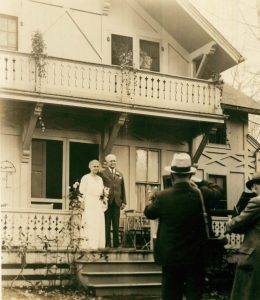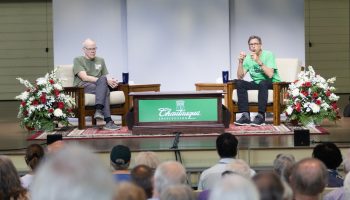Four years after the death of Thomas Edison, his 70-year-old widow Mina married Edward E. Hughes, a widower and retired steel company executive. There is a considerable amount of mystery regarding the nature of their relationship prior to their marriage and about how they reconnected after the deaths of their first spouses. The answer to both questions lies in the documents at the Oliver Archives Center at Chautauqua.
Some accounts have erroneously claimed Mina and Ed were “childhood sweethearts.” The source for that claim is an Associated Press article published on the day of their wedding under the title “Edison’s Widow to Wed Childhood Sweetheart.” The article was closer to the mark in noting that Ed, who was almost four years older than Mina, was a “childhood friend” and that the two had “played together as children” at the Lewis Miller Cottage.
The Hughes family was among Chautauqua’s earliest summer residents. The property records in the Oliver Archives Center indicate that Ed’s mother secured a lease on a cottage at 3 Whitfield in 1877. The Hughes Cottage was a short walk from the Miller Cottage, so Mina and Ed must have had plenty of opportunities to interact during their summers at Chautauqua. Nonetheless, the editors of the Edison Papers have found only two references to Ed in the family correspondence prior to 1935 (the year of their marriage) and none by Mina herself.
Six recently published letters from Mina to her son Theodore and daughter-in-law Ann in the Miller Family Papers at the Oliver Archives Center provide some interesting insight into the whirlwind courtship of Ed and Mina. The first letter, dated Feb. 17, 1935, was written from Seminole Lodge, the Edison family’s winter home in Fort Myers, Florida. Near the end of the letter, Mina offhandedly remarks that “Mr. Hughes has made us a visit but has now gone back to Deland. He loved it here and says he wants to come again.” Ed typically spent part of the winter at the College Arms Hotel in DeLand, Florida (about 200 miles east of Fort Myers), where he could indulge his passion for golfing. Given the distance, Ed’s February visit to Seminole Lodge was certainly not a day trip.
By March 15, Ed was back in Fort Myers and not in the best of health. As Mina explained, “he has been very ill with tonsilitis having taken cold after playing golf at Deland.” Instead of staying at his hotel to recuperate, Ed had decided to make the long trip back to Fort Myers. He was still at Seminole Lodge — and still not fully recovered — on March 27, when Mina wrote Theodore and Ann again, expressing concern that “he gets so exhausted after any effort or exertion.” There is no evidence that Ed returned to DeLand after his second visit to Fort Myers. What we know for certain is that when Mina left Fort Myers on “a leisurely motor trip north” at the end of April, Ed (as The New York Times reported) “was a member of the party with Mrs. Edison.”
The next letter by Mina dates from July 25, and the letterhead indicates that it was written at the Miller Cottage. It’s a playful letter, and one can almost imagine Mina giggling as she wrote it.
“Today I am running away as I am meeting a very, very dear friend of mine. Can you guess? Well I have decided that life is pretty forlorn without him and he seems to feel the same about me and so — Sometime in the fall you may be expecting the announcement of a step two human souls are taking. Neither of us ever, ever forgetting or loving less our lifetime companions but they are both silently sleeping, tenderly loved, and … we are left behind alone and find in each other a consolation and contentment.”
Mina and Ed were married in the living room of the Miller Cottage on Oct. 30, 1935. It was “a simple service” attended only by “members of immediate families and a few intimate friends.” The marriage lasted scarcely more than four years, with Ed passing away on January 19, 1940. Almost immediately afterwards, Mina resumed using the name Edison.
Thomas E. Jeffrey is associate director and senior editor of the Thomas Edison Papers at Rutgers University. He also teaches a course in early American history at Rutgers.





